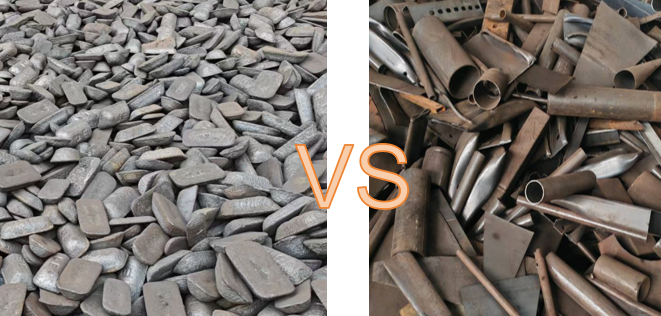Why Steelmakers Choose Pig Iron Even Though It Costs More Than Steel Scrap
2025-09-23 17:28:21 hits:0
In steel production, steel scrap may be cheaper upfront, but its composition is unstable and often contains impurities such as copper, tin, lead, and zinc. To meet high-grade steel standards, mills must add various alloying elements and refining agents during the steelmaking process. This increases the overall cost of using scrap, and the final product quality still cannot fully match that of pig iron.

1. Common Impurities in Scrap and Required Additives
Carbon Adjustment
Scrap carbon content is often uneven and must be supplemented with pig iron, coke, or carbon powder in the furnace.
This ensures that the final steel achieves the target carbon content (typically 0.1%–0.5% for low-carbon steels).
Manganese (Mn)
Scrap manganese content varies, requiring addition of ferromanganese to improve strength and hardenability.
Manganese also binds with sulfur to reduce steel brittleness.
Silicon (Si)
Acts as a deoxidizer and enhances elasticity and hardness. Scrap with inconsistent silicon content requires ferrosilicon supplementation.
Chromium, Nickel, Molybdenum, and Other Alloying Elements
High-grade steels require precise levels of these elements. Mills add ferroalloys (chromium iron, nickel iron, molybdenum iron, etc.) to reach target compositions.
These elements are added in the electric or refining furnace, with careful monitoring of temperature and reactions.
Deoxidizers and Refining Agents
Includes limestone, dolomite, and iron oxide powders, used to remove sulfur, phosphorus, and control oxygen content.
Added to the furnace, they react with scrap to form slag, which is then removed.
Desulfurizing Agents
Scrap often has higher sulfur content and requires calcium fluoride, calcium iron alloy, or similar agents to remove sulfur.
Through high-temperature melting and stirring, sulfur combines with the desulfurizing agent and is removed in the slag.
2. Addition Process and Costs
In electric arc or induction furnaces, scrap steel processing generally involves:
Furnace Charge Calculation – Determine quantities of scrap, alloying elements, and refining agents based on composition analysis.
Stepwise Alloy Addition – Add manganese, silicon, and other main alloys first while controlling temperature for uniform reactions.
Deoxidation and Desulfurization – Add limestone, calcium iron alloy, and other refining agents, stir to remove harmful elements.
Carbon Adjustment – Add pig iron, coke, or carbon powder to reach target carbon levels.
Quality Testing – Sample molten steel and adjust alloy or carbon content as necessary.
This process is complex, time-consuming, and energy-intensive. Each addition of alloying elements and refining agents increases material costs. Even if scrap is cheaper initially, the overall cost may exceed that of using pig iron.
3. Advantages of Pig Iron
By contrast, pig iron offers stable composition, high purity, and minimal impurities:
Can be directly added to furnaces or blended with scrap without extensive alloy adjustments.
Ensures consistent carbon, manganese, silicon, and other key elements, making high-quality steel production easier.
Reduces additive costs, lowers rework rates, and improves production efficiency.
Conclusion
Price alone does not determine the optimal raw material. While scrap steel is environmentally friendly and inexpensive, producing high-quality steel with scrap requires additional alloying and refining steps, increasing overall cost and complexity, while still not fully matching pig iron in quality. Pig iron remains a critical choice for ensuring steel quality, production stability, and long-term cost efficiency.
If your business relies on pig iron, staying updated on market trends is essential. Contact us to learn about the latest 2025 pig iron price trends and discover reliable sourcing solutions tailored to your steelmaking needs.

 en
en  fra
fra  de
de  ru
ru  ara
ara  gle
gle  it
it  jp
jp  kor
kor  th
th  zh
zh 


